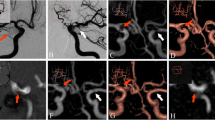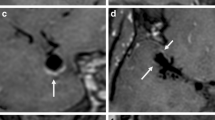Abstract
Objective
This study aimed to compare the efficacy of enhanced 3D T1-weighted black-blood fast-spin-echo vessel wall magnetic resonance imaging (eVW-MRI) and time-of-flight magnetic resonance angiography (TOF MRA) for follow-up evaluation of aneurysms treated with flow diversion (FD).
Methods
Our study enrolled 77 patients harboring 84 aneurysms treated with FD. Follow-up was by MRI (eVW-MRI and TOF MRA) and digital subtraction angiography (DSA). Two radiologists, blinded to DSA examination results, independently evaluated the images of aneurysm occlusion and parent artery patency using the Kamran-Byrne Scale. Interobserver diagnostic agreement and intermodality diagnostic agreement were acquired. Pretreatment and follow-up aneurysm wall enhancement (AWE) patterns were collected.
Results
Based on the Kamran-Byrne Scale, the intermodality agreement between eVW-MRI and DSA was better than TOF MRA versus DSA for aneurysm remnant detection (weighted ĸ = 0.891 v. 0.553) and parent artery patency (ĸ = 0.950 v. 0.221). Even with the coil artifact, the consistency of eVW-MRI with DSA for aneurysm remnant detection was better than that of TOF MRA (weighted ĸ = 0.891 v. 0.511). The artifact of adjunctive coils might be more likely to affect the accuracy in evaluating parent artery patency with TOF MRA than with eVW-MRI (ĸ = 0.077 v. 0.788). The follow-up AWE patterns were not significantly associated with pretreatment AWE patterns and aneurysm occlusion.
Conclusions
The eVW-MRI outperforms TOF MRA as a reliable noninvasive and nonionizing radioactive imaging method for evaluating aneurysm remnants and parent artery patency after FD. The significance of enhancement patterns on eVW-MRI sequences needs more exploration.
Clinical relevance statement
The application of enhanced vessel wall magnetic resonance imaging has proven to be a promising tool to depict aneurysm remnant and parent artery stenosis in order to tailor the antiplatelet therapy strategy in patients after flow diversion.
Key Points
• Enhanced vessel wall magnetic resonance imaging has an emerging role in depicting aneurysm remnant and parent artery patency after flow diversion.
• With or without the artifact from adjunctive coils, enhanced vessel wall magnetic resonance imaging was better than TOF MRA in detecting aneurysm residual and parent artery stenosis by using DSA imaging as the standard.
• Enhanced vessel wall magnetic resonance imaging holds potential to be used as an alternative to DSA for routine aneurysm follow-up after flow diversion.




Similar content being viewed by others
Abbreviations
- AWE:
-
Aneurysm wall enhancement
- CE MRA:
-
Contrast-enhanced magnetic resonance angiography
- CI:
-
Confidence interval
- CTA:
-
Computed tomography angiography
- DSA:
-
Digital subtraction angiography
- eVW-MRI:
-
Enhanced vessel wall magnetic resonance imaging
- FD:
-
Flow diversion
- ĸ :
-
Kappa value
- PED:
-
Pipeline embolization device
- SD:
-
Standard deviation
- TOF MRA:
-
Time-of-flight magnetic resonance angiography
References
Hanel RA, Kallmes DF, Lopes DK et al (2020) Prospective study on embolization of intracranial aneurysms with the pipeline device: the PREMIER study 1 year results. J Neurointerv Surg 12:62–66
Kallmes DF, Brinjikji W, Cekirge S et al (2017) Safety and efficacy of the pipeline embolization device for treatment of intracranial aneurysms: a pooled analysis of 3 large studies. J Neurosurg 127:775–780
Chalouhi N, Tjoumakaris S, Starke RM et al (2013) Comparison of flow diversion and coiling in large unruptured intracranial saccular aneurysms. Stroke 44:2150–2154
Schaafsma JD, Velthuis BK, van den Berg R et al (2012) Coil-treated aneurysms: decision making regarding additional treatment based on findings of MR angiography and intraarterial DSA. Radiology 265:858–863
Attali J, Benaissa A, Soize S, Kadziolka K, Portefaix C, Pierot L (2016) Follow-up of intracranial aneurysms treated by flow diverter: comparison of three-dimensional time-of-flight MR angiography (3D-TOF-MRA) and contrast-enhanced MR angiography (CE-MRA) sequences with digital subtraction angiography as the gold standard. J Neurointerv Surg 8:81–86
Duarte CM, de Korte AM, Meijer F et al (2018) Subtraction CTA: an alternative imaging option for the follow-up of flow-diverter-treated aneurysms? AJNR Am J Neuroradiol 39:2051–2056
Shao Q, Wu Q, Li Q et al (2020) Usefulness of 3D T1-SPACE in combination with 3D-TOF MRA for follow-up evaluation of intracranial aneurysms treated with pipeline embolization devices. Front Neurol 11:542493
Fu Q, Wang Y, Zhang Y et al (2021) Qualitative and quantitative wall enhancement on magnetic resonance imaging is associated with symptoms of unruptured intracranial aneurysms. Stroke 52:213–222
Raz E, Goldman-Yassen A, Derman A, Derakhshani A, Grinstead J, Dehkharghani S (2022) Vessel wall imaging with advanced flow suppression in the characterization of intracranial aneurysms following flow diversion with pipeline embolization device. J Neurointerv Surg 14:1264–1269
Kamran M, Yarnold J, Grunwald IQ, Byrne JV (2011) Assessment of angiographic outcomes after flow diversion treatment of intracranial aneurysms: a new grading schema. Neuroradiology 53:501–508
Kuhn AL, Hou SY, Perras M et al (2015) Flow diverter stents for unruptured saccular anterior circulation perforating artery aneurysms: safety, efficacy, and short-term follow-up. J Neurointerv Surg 7:634–640
Ahmed SU, Mocco J, Zhang X et al (2019) MRA versus DSA for the follow-up imaging of intracranial aneurysms treated using endovascular techniques: a meta-analysis. J Neurointerv Surg 11:1009–1014
Boddu SR, Tong FC, Dehkharghani S, Dion JE, Saindane AM (2014) Contrast-enhanced time-resolved MRA for follow-up of intracranial aneurysms treated with the pipeline embolization device. AJNR Am J Neuroradiol 35:2112–2118
Zwarzany L, Owsiak M, Tyburski E, Poncyljusz W (2022) High-resolution vessel wall MRI of endovascularly treated intracranial aneurysms. Tomography 8:303–315
Gory B, Sigovan M, Vallecilla C, Courbebaisse G, Turjman F (2015) High-resolution MRI visualization of aneurysmal thrombosis after flow diverter stent placement. J Neuroimaging 25:310–311
Halitcan B, Bige S, Sinan B et al (2021) The implications of magnetic resonance angiography artifacts caused by different types of intracranial flow diverters. J Cardiovasc Magn Reson 23:69
Quan T, Ren Y, Lin Y et al (2019) Role of contrast-enhanced magnetic resonance high-resolution variable flip angle turbo-spin-echo (T1 SPACE) technique in diagnosis of transverse sinus stenosis. Eur J Radiol 120:108644
Shang S, Ye J, Luo X, Qu J, Zhen Y, Wu J (2017) Follow-up assessment of coiled intracranial aneurysms using zTE MRA as compared with TOF MRA: a preliminary image quality study. Eur Radiol 27:4271–4280
Marciano D, Soize S, Metaxas G, Portefaix C, Pierot L (2017) Follow-up of intracranial aneurysms treated with stent-assisted coiling: comparison of contrast-enhanced MRA, time-of-flight MRA, and digital subtraction angiography. J Neuroradiol 44:44–51
Xiang S, Fan F, Hu P et al (2021) The sensitivity and specificity of TOF-MRA compared with DSA in the follow-up of treated intracranial aneurysms. J Neurointerv Surg 13:1172–1179
Oishi H, Fujii T, Suzuki M et al (2019) Usefulness of silent MR angiography for intracranial aneurysms treated with a flow-diverter device. AJNR Am J Neuroradiol 40:808–814
Pravdivtseva MS, Gaidzik F, Berg P et al (2021) Pseudo-enhancement in intracranial aneurysms on black-blood MRI: effects of flow rate, spatial resolution, and additional flow suppression. J Magn Reson Imaging 54:888–901
Elsheikh S, Urbach H, Meckel S (2020) Contrast enhancement of intracranial aneurysms on 3T 3D black-blood MRI and its relationship to aneurysm recurrence following endovascular treatment. AJNR Am J Neuroradiol 41:495–500
Acknowledgements
The authors are grateful to Dr. Jingliang Cheng for his kind instruction on VW-MRI.
Funding
The authors state that this work has not received any funding.
Author information
Authors and Affiliations
Corresponding authors
Ethics declarations
Guarantor
The scientific guarantor of this publication is Sheng Guan.
Conflict of interest
The authors of this manuscript declare no relationships with any companies, whose products or services may be related to the subject matter of the article.
Statistics and biometry
One of the authors has statistical expertise and provided statistical advice.
Informed consent
Written informed consent was obtained from all patients in this study.
Ethical approval
Institutional review board approval was obtained.
Study subjects or cohorts overlap
No study subject has been previously reported.
Methodology
• retrospective
• observational
• performed at one institution
Additional information
Publisher's note
Springer Nature remains neutral with regard to jurisdictional claims in published maps and institutional affiliations.
Supplementary Information
Below is the link to the electronic supplementary material.
Rights and permissions
Springer Nature or its licensor (e.g. a society or other partner) holds exclusive rights to this article under a publishing agreement with the author(s) or other rightsholder(s); author self-archiving of the accepted manuscript version of this article is solely governed by the terms of such publishing agreement and applicable law.
About this article
Cite this article
Quan, T., Ren, Y., Li, J. et al. Enhanced vessel wall magnetic resonance imaging in the follow-up of intracranial aneurysms treated with flow diversion. Eur Radiol 34, 833–841 (2024). https://doi.org/10.1007/s00330-023-10094-4
Received:
Revised:
Accepted:
Published:
Issue Date:
DOI: https://doi.org/10.1007/s00330-023-10094-4




